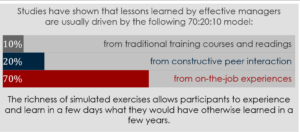Experiential Learning: Users' Guide
By Admin
Understand how experiential learning works and its impact in the classroom.
From our corporate learning development entity, StratX Corporate, we would like to share some key elements from their Experiential Learning User’s Guide that pertain to academic learning and results.
What is experiential learning?
Experiential Learning, simply put, is learning by doing. It allows participants to develop and acquire new skills in a safe environment that reflects real-world situations in an ultra-compressed timeframe. Participants can experience years of market activities in a matter of days or even hours.
Experiential learning has a long tradition that can be traced back to ancient civilizations, including Chinese, Greek and Egyptian societies. Closer to our time, psychologists have been using child development as one of the greatest examples of experiential learning: the ability to learn by exploring, making mistakes, experimenting, and learning, all by oneself
The theory was made popular in an educational and business context by theorist David A. Kolb, who, along with John Fry, developed the experiential learning theory, which is based on the idea that learning is a process whereby knowledge is created through transformation of experience. It is based on four main elements which operate in a continuous cycle during the learning experience:
- Concrete experience
- Reflective observation
- Abstract conceptualization
- Active experimentation
This framework has been widely applied, extended and criticized. Today, there is a general recognition that these four aspects are the pillars of experiential learning, although they are not necessarily followed systematically and sequentially, but rather in an interactive and iterative fashion.
Why use experiential learning?
Mirroring real-world decision-making experiences in a competitive environment, experiential learning helps to create emotionally-charged environments, leading to results. It engages participants on a higher level and embeds real and lasting results due to the fact that they are experiencing concepts and challenges that they wouldn’t otherwise encounter through traditional learning methods.
Studies have shown that lessons learned by effective managers are usually driven by the following 70:20:10 model:
- 70% from on-the-job experiences
- 20% from constructive peer interaction
- 10% from training courses and reading
While most courses only contribute to the bottom 10%, experiential learning programs focus on providing realistic, risk-free competitive environments where participants learn through experience (the 70%) while also working in cross-functional and cross-market teams (the 20%).
The result of this approach is that participants will learn through a much broader experience, resulting in much longer-lasting changes in knowledge and behavior.
What are the benefits of experiential learning?
Risk-Free, Real-World Application – The participant personally experiences concepts “hands on” in a controlled, risk-free environment in which mistakes are not only allowed, but encouraged as part of the learning process. Participants combine their experiences in the learning environment with abstract concepts in order to reflect on the outcome. By analyzing the impact of their actions on results, they can understand how key concepts can be applied to real-life circumstances.
Motivation – When designed, developed, and delivered properly, experiential learning can engage and motivate participants more compellingly than other forms of learning. Through the process and the results of their activities, participants see the value in what they are learning more clearly.
Team Work – Participants from different backgrounds with different levels of experience can both teach and learn from each other. In addition to concepts, participants develop skills more effectively together.
Creativity – Participants can seek their own solutions to challenges put before them and adapt to changing circumstances.
It’s Fun – It’s engaging, challenging, memorable and fun. It tickles the brain in a way that traditional learning methods don’t. In this day and age, it’s nearly impossible to capture the attention of students for more than twenty minutes. In experiential learning programs, it can be a struggle to pull them away from the experiences the simulations create, sometime for hours at a time. With all the distractions and a constant bombardment of emails and texts, this is absolutely priceless.
To access StratX Corporate’s Experiential Learning User’s Guide, click here.


%20(LinkedIn%20Sponsored%20Content)%20(86)-min.png?width=352&name=Green%20and%20Black%20Live%20Podcast%20Guesting%20Instagram%20Post%20(600%20%C3%97%20250%20px)%20(LinkedIn%20Sponsored%20Content)%20(86)-min.png)
%20(LinkedIn%20Sponsored%20Content)%20(55)-min.png?width=352&name=Green%20and%20Black%20Live%20Podcast%20Guesting%20Instagram%20Post%20(600%20%C3%97%20250%20px)%20(LinkedIn%20Sponsored%20Content)%20(55)-min.png)
.png?width=352&name=AI%20Webinar%20Banner%20-%20LinkedIn%20(5).png)